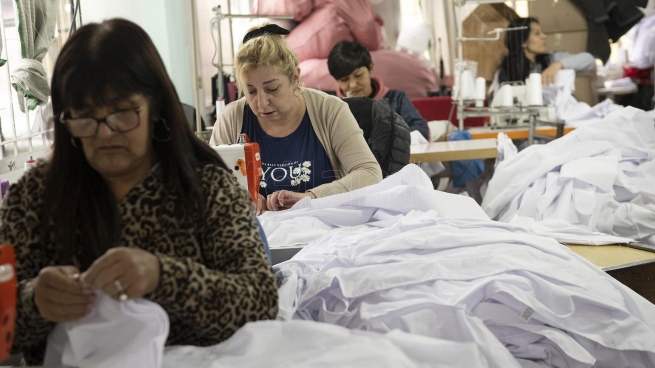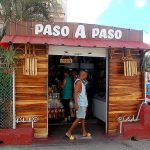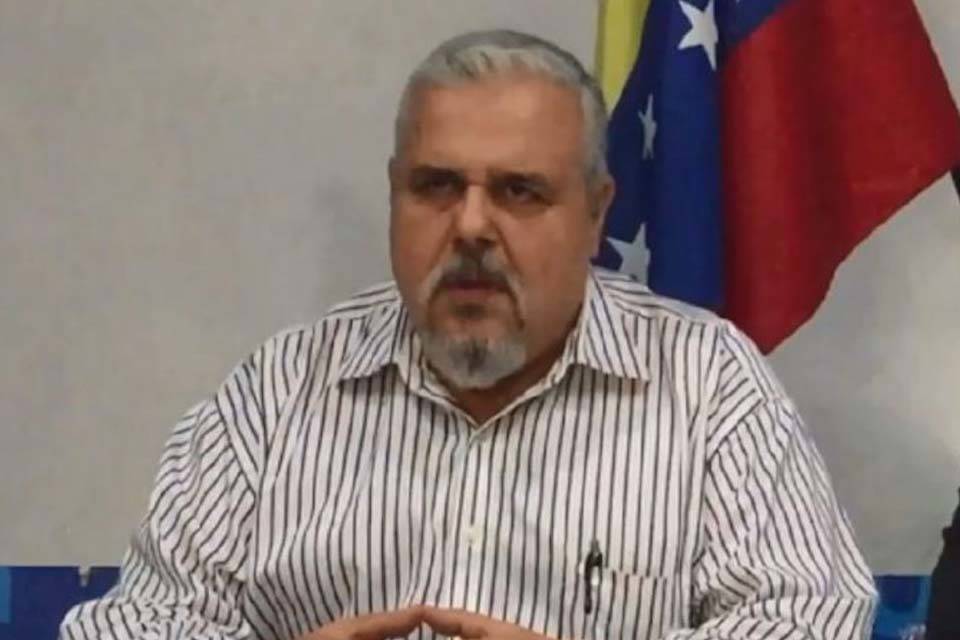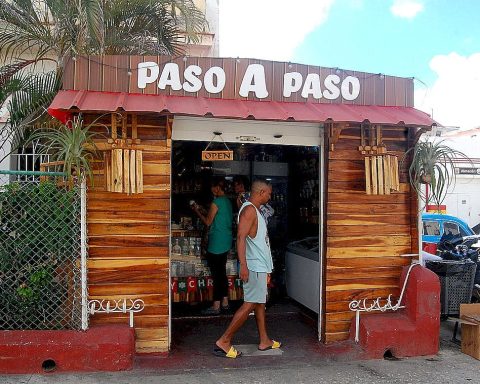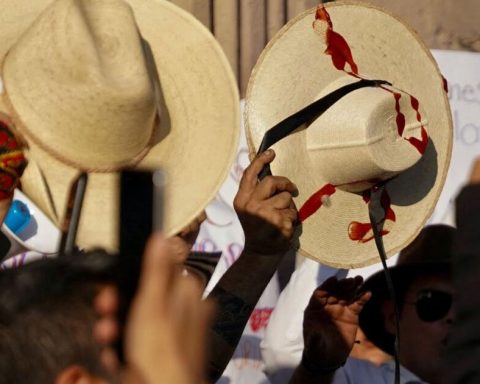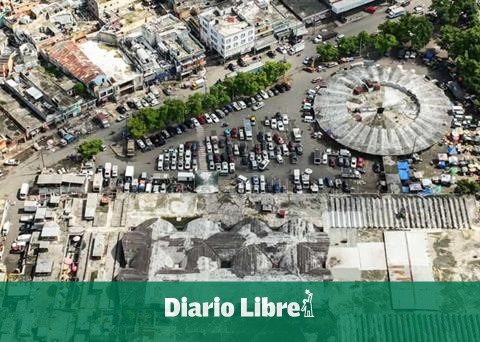They look like little ants because of the degree of organization of the work.
A group of men ends up on the ground floor the borceguies they make usually for sale, but this time they hurry so that the organization’s colleagues have for the mobilization of San Cayetano.
In the kitchen, men and women meticulously prepare what will be the workers’ lunch. And the first floor looks like, or rather is, a textile factory: dozens of seamstresses make overallswork clothes, both and even dress clothes that Dina Sánchez (42), deputy general secretary of the Union of Workers of the Popular Economy and spokesperson for the Darío Santillán Popular Front, is going to look at and buy when she comes to greet her colleagues from the textile complex they have in Avellaneda, right next to the station where Maximiliano Kosteki and Darío Santillán were murdered.
Dina arrives on a motorcycle for the talk with Télam and immediately exhibits that immense smile that is her watermark, along with her taut hair, tied in a ponytail that reveals part of what is guessed a protagonist curly hair as rebellious as she is.
Because Dina did not have it and does not have it easy, but she has plenty of energy to fight. Five years ago they killed a son that he had fallen into drug trafficking networks; Since she was 20 years old, she took care of her two children alone and in 2010 she settled permanently in Argentina and left her native Peru behind.
He is going to say that social plans should not be converted into work and as an example is the Avellaneda textile pole that works like a full steam ship. That what is needed is that the work they already do be covered with rights.
Of all the productive units that the Darío Santillán Popular Front has, 13 are in the Metropolitan Area of Buenos Aires (AMBA). And in the whole country there are 32.
Essentially, they market the products to the national and provincial states and the Autonomous City of Buenos Aires. Do you charge a plan? Dina says that it is a complementary social salary, which is now called Empower Work. It’s 22 thousand pesos per month for four hours of work. But they do so much that the rest of the time they keep working.

In a pandemic, they made chinstraps, camisoles and gel alcohol. And it occurred to a colleague to start testing with Cleaning products that they themselves package and sell through the website of the Popular Consumer Market (MECOPO). They also make products from blacksmithing, carpentry, serigraphyhave senior centers and in Barracas one for children with problematic drug use, in addition to a market in constitution to which the neighbors of the neighborhood go directly.
“Drug trafficking is very involved in popular neighborhoods, I always ask myself as a mother how can it be that we know where the transa is who sells drugs to my kid and the police don’t. Lie. And I’m telling you with good reason because I also went through a problem like this with my son,” says Dina when she explains that the Barracas center was installed there because it is close to the village.
But many people prefer to repeat what the mainstream media says to think, let alone verify what they are told. And a kind of mantra was installed in an important part of society that says that “planeros are lazy people who picket every day and don’t let me work”.

-Dina, what do you feel when the media accuse you of being lazy and question the demonstrations?
-The mobilization is the method of struggle that we have. If not, it’s “fuck you, that’s it” and things don’t work out. It’s very easy to say don’t mobilize, but we don’t have a television channel and they don’t give us much of a ball.
And we watch TV, I come from the province like many colleagues. And they leave very early, they live in popular neighborhoods very far away. To get out of Glew, I had to buy a motorcycle. I live about 20 blocks from the station. There aren’t many buses and at rush hour everyone leaves and they don’t stop you. Can you walk? Of course we have, we’ve done it a lot, but twice I got robbed in the corner. The garbage truck does not pass through my neighborhood and I have to leave it every day in a container that is well placed, about a block away. One day I went to the container and the jet was in the back. And it has also happened to us because the train was cut off due to a mobilization of fellow workers who were stranded and we understand them because each one fights from where he can.

“A Petite Jetona”
Dina joined the popular economy, the “orga”, as she calls it, in 2010. She had been kicked out of the Walmart supermarket and had two small children to feed alone. Since then, she has been growing at UTEP under the guidance of Juan Grabois and has been training. She finished high school and now is very close to graduating in social economics at the University of Quilmes.
But beyond her training and the fact that she was always interested in reading the newspapers and being informed, it is her charisma that made her colleagues choose her as spokesperson for the Darío Santillán Front.
She defines herself as “a petisa jetona” and in addition to her smile, her sense of humor and her energy are contagious. “My three-year-old granddaughter’s pediatrician has to eat red meat twice a week. I tell her that’s fine, but let her buy it,” she laughs.
But then he explains that In popular neighborhoods, the first thing they run out of is lasa, chicken wings, offal and the back. Because it is obviously the cheapest.
And he laughs and complains that when for his last birthday, his son Joel asked him for stuffed potatoes, a typical Peruvian food, the oil had increased so much that he told him that it was the last time he would make it, that he should not think of it ask for more fritters.
When he goes to greet the seamstresses, he looks at everything they are doing and falls in love with a colorful jumper that costs 300 pesos. Before buying it, ask for a discount. “In Peru we haggle all the time, here they look at you badly,” he says and laughs again while they look for one of his size because the exhibited one was too big for his petite body that ends in a pair of feet whose size is 35.

But being Peruvian is not always easy for her.
Being an immigrant in Argentina
I had just finished the census and Dina was studying at UNQUI. Two colleagues had acted as census takers and commented that all the people she had trouble interviewing were Peruvians. To which a colleague added: “Peruvians are all drug traffickers.”
She obviously wasn’t going to keep quiet.
– What did you do, Dinah?
I raised my hand and told the teacher that I couldn’t keep quiet. I told them my story, that I have been working since I was 17 years old and that my son was killed in Villa 31 after being co-opted by drug traffickers for a long time. I told them that in the village there is everything, working people and criminals, like everywhere. The same goes for Peruvians.
the nameless pain
It is often said, but there is no noun to designate the condition of a father or a mother who lost a child. Nahuel was killed at the age of 19, five years ago, despite the fact that she went into Villa 31 to fight with the “transas” who had him and other kids consuming, selling, and lying on mattresses, completely drunk. lap.

Sometimes she managed to take him home, but he would go away again. Until one day he received the fatal call: he was dying in a hospital, someone had tried to kill him and he died.
How did you manage to cope with that pain?
-When my son happened, my family couldn’t come and the “orga” gave me a lot of support. That pain turned into a fight (Dina cries for the only time in the interview), into a great desire to move on. What was terrible is that even the father accused me of spending all my time in the street and therefore of his death.. Always the pointing finger. And the truth is, my children grew up as they could because they had to support two kids alone. Pointing is very easy.
They told me at the “orga” that I had to address the issue with help because it wasn’t easy because of the guilt. My children were two years apart, the brother, Joel, got into drugs at first because he was lost, but today he works as a delivery man and is a father. I have a granddaughter who is about to turn four. One has to learn to live with a lot of situations.
I listen a lot the constant stigmatization of kids who consume, especially the questioning falls on the issue of parents. And the parents are doing what they can, there are a lot of moms who leave the kids alone because they have to go out to work. Behind every kid who consumes there is a story of pain.

To the elbows with the men
Her exposure grew and today she has a lot of visibility among social leaders, but Dina says that her colleagues still have a hard time making room for her. She loads them.
“Comrades how do you like to be in the photo, what cool are you“, she tells them and she is a little serious. Dina says that they love to grab the microphone and that in the photos many times she has to go forward because she is petite and if not, she does not appear in the photos. But she does.
For San Cayetano, he is going to march with his companions with the usual demands, but with the axis in the universal basic salary.
-Dina, what would you say to those who complain that they mobilize?
-That I am Peruvian, but I studied Argentine history a lot. To those who send us to work, I would say that this country has something deeply rooted. All the labor rights of those who have, in quotes, the “privilege” of having a formal job (because they are having a hard time too), remember that these rights have been won on the street. In mobilizations like the ones that criticize us.
